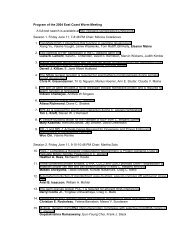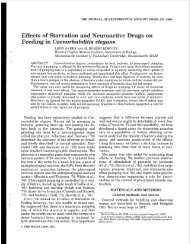West Coast Worm Meeting Abstracts - Caenorhabditis elegans ...
West Coast Worm Meeting Abstracts - Caenorhabditis elegans ...
West Coast Worm Meeting Abstracts - Caenorhabditis elegans ...
Create successful ePaper yourself
Turn your PDF publications into a flip-book with our unique Google optimized e-Paper software.
<strong>West</strong> <strong>Coast</strong> <strong>Worm</strong> <strong>Meeting</strong> 2000<br />
NEUROTOXIN SENSITIVITY OF DOPAMINERGIC NEURONS<br />
IN C. ELEGANS: ROLE OF THE DOPAMINE TRANSPORTER<br />
AND CELL DEATH PATHWAYS<br />
R. Nass 1,2 , J. Duerr 3 , , J. Rand 3 , D. M. Miller 2,4 , R. D. Blakely 1,2<br />
1Dept of Pharmacol, Vanderbilt U. Med. School, Nashville, TN<br />
2Ctr. for Molecular Neuroscience, Vanderbilt U. Med. School, Nashville, TN<br />
3Program in Molecular and Cell Biology, OMRF, Oklahoma City, OK<br />
4Dept of Cell Biology, Vanderbilt U. Med. School, Nashville, TN<br />
The dopamine transporter (DAT) constitutes the primary mechanism for the inactivation of dopamine (DA)<br />
neurotransmission in the brain. DATs are targets for many psychoactive drugs and the cellular gateway<br />
for the accumulation of the neurotoxin 6-hydroxydopamine (6-OHDA) which evokes neuronal death and<br />
Parkinson-like syndrome in animal models. We have previously cloned and tagged the C. <strong>elegans</strong> DAT<br />
(CeDAT), and have shown that it is functionally similar to mammalian DATs and expressed exclusively in<br />
the DA neurons (Jayanthi et al. 1998, Nass et al. 1999). We have also developed WT and DAT knockout<br />
transgenic lines which target a CeDAT promotor-GFP fusion to all 8 DA neurons in the hermaphrodite.<br />
Intense GFP expression is seen throughout the axons and dendrites in the live animals. We now show<br />
that a brief exposure to 6-OHDA results in the blebbing of DA neuronal processes, swelling of DA<br />
neuronal cell bodies, and the loss of CeDAT-GFP expression, while co-exposure with CeDAT substrates<br />
or antagonists significantly reduces the 6-OHDA induced response. We also show that this response is<br />
dependent on the expression of CeDAT, since the CeDAT knockout line is insensitive to the effects of the<br />
neurotoxin. Furthermore, the effect appears to be dependent on a necrotic cell death pathway, since the 6<br />
OHDA induced response occurs in a caspase-deficient ced-3 knockout background. These studies as<br />
well as our progress on toxin-based genetic screens for regulators of CeDAT function, localization, and<br />
the toxin mediated cell death will be presented. Supported by MH19732-07 (RN), GM38679 (JR),<br />
NS26115 (DMM), MH58921 (RDB)<br />
50




